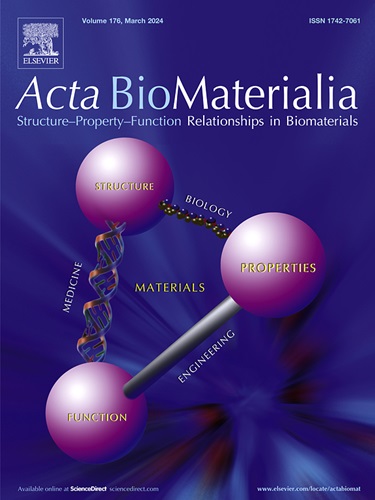通过协同凋亡/铁凋亡/免疫原性细胞死亡增强抗胶质瘤治疗的载药人工线粒体转移
IF 9.4
1区 医学
Q1 ENGINEERING, BIOMEDICAL
引用次数: 0
摘要
线粒体靶向治疗胶质瘤是一种新的治疗策略,通过有效地利用胶质瘤细胞在线粒体水平上的固有脆弱性,具有提高药物敏感性的巨大潜力。在这项研究中,我们开发了一种复杂的纳米递送系统,通过从线粒体膜为基础的纳米囊泡中工程化人工线粒体,实现阿霉素(Dox)的精确靶向,选择性地消灭癌细胞,同时放大多种细胞死亡途径。研究发现,包裹dox的线粒体基纳米囊泡(DOX-MitoNVs)表现出非凡的穿透血脑屏障(BBB)的能力,特别是针对胶质瘤。Dox - mitonvs通过靶向线粒体而不是浸润细胞核,不仅通过细胞内Ca2+超载放大Dox介导的凋亡效应,而且通过产生活性氧(ROS)加剧铁凋亡。此外,DOX-MitoNVs显示出显著的调节肿瘤免疫微环境的能力,从而诱导显著的免疫原性细胞死亡(ICD)效应。总之,它提出了一种新的治疗策略,利用dox - mitonv在胶质瘤中精确靶向线粒体,增强药物敏感性,诱导多种细胞死亡途径,调节肿瘤免疫微环境以促进免疫原性细胞死亡。意义声明:线粒体靶向治疗胶质瘤是一种很有前途的治疗策略,通过利用胶质瘤细胞的线粒体脆弱性来提高药物敏感性。我们从线粒体膜为基础的纳米囊泡中设计了人工线粒体,作为一种精确靶向阿霉素的新型纳米递送系统。这种方法有助于选择性癌细胞根除和放大多种细胞死亡途径与免疫原性化疗。值得注意的是,DOX-MitoNVs包封线粒体纳米囊泡(DOX-MitoNVs)可以有效地穿过血脑屏障(BBB)并特异性靶向胶质瘤。Dox主要作用于线粒体,通过活性氧(reactive oxygen species, ROS)的产生诱导细胞凋亡并加剧铁下垂。此外,DOX-MitoNVs可以改变肿瘤免疫微环境,促进免疫原性细胞死亡(ICD)。总的来说,dox - mitonv为增强胶质瘤治疗提供了一个令人信服的平台。本文章由计算机程序翻译,如有差异,请以英文原文为准。

Mitochondrial transfer of drug-loaded artificial mitochondria for enhanced anti-Glioma therapy through synergistic apoptosis/ferroptosis/immunogenic cell death
Mitochondrial targeting in gliomas represents a novel therapeutic strategy with significant potential to enhance drug sensitivity by effectively killing glioma cells at the mitochondrial level. In this study, we developed artificial mitochondria derived from mitochondrial membrane-based nanovesicles, enabling precise mitochondrial targeting of doxorubicin (Dox) to selectively eradicate cancer cells by amplifying multiple cell death pathways. It was found that Dox-encapsulating mitochondria-based nanovesicles (DOX-MitoNVs) exhibited an extraordinary ability to penetrate the blood-brain barrier (BBB), specifically targeting gliomas. By targeting mitochondria instead of locating at the nucleus, DOX-MitoNVs not only amplified Dox mediated apoptosis effects through the overloading of intracellular Ca2+ but also intensified ferroptosis by generating reactive oxygen species (ROS). Furthermore, DOX-MitoNVs demonstrated a significant ability to modulate the tumor immune microenvironment, thereby inducing pronounced immunogenic cell death (ICD) effects. In summary, it presents a novel therapeutic strategy utilizing DOX-MitoNVs for precise mitochondrial targeting in gliomas, enhancing drug sensitivity, inducing multiple cell death pathways, and modulating the tumor immune microenvironment to promote immunogenic cell death.
Statement of Significance
Mitochondrial targeting in gliomas is a promising therapeutic strategy that enhances drug sensitivity by exploiting glioma cells' mitochondrial vulnerabilities. We engineered mitochondrial membrane-based nanovesicles as artificial mitochondria for precise mitochondrial targeting of Dox. This approach facilitates selective cancer cell eradication and amplifies multiple cell death pathways alongside immunogenic chemotherapy. Notably, DOX-MitoNVs effectively cross the BBB and specifically target gliomas. By focusing on mitochondria, Dox induces apoptosis and intensifies ferroptosis through ROS generation. Additionally, DOX-MitoNVs can transform the tumor immune microenvironment, promoting ICD. Overall, DOX-MitoNVs offer a promising platform for enhanced glioma therapy.
求助全文
通过发布文献求助,成功后即可免费获取论文全文。
去求助
来源期刊

Acta Biomaterialia
工程技术-材料科学:生物材料
CiteScore
16.80
自引率
3.10%
发文量
776
审稿时长
30 days
期刊介绍:
Acta Biomaterialia is a monthly peer-reviewed scientific journal published by Elsevier. The journal was established in January 2005. The editor-in-chief is W.R. Wagner (University of Pittsburgh). The journal covers research in biomaterials science, including the interrelationship of biomaterial structure and function from macroscale to nanoscale. Topical coverage includes biomedical and biocompatible materials.
 求助内容:
求助内容: 应助结果提醒方式:
应助结果提醒方式:


